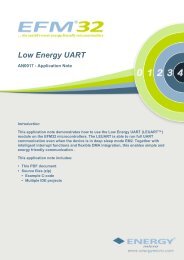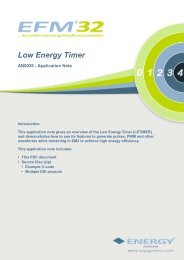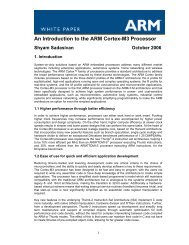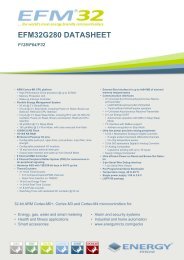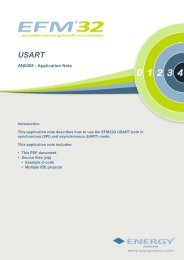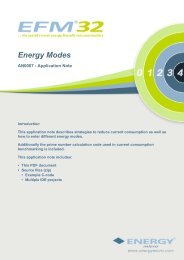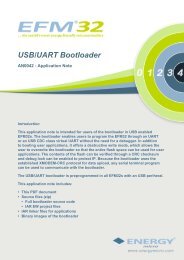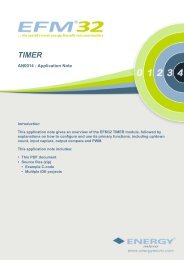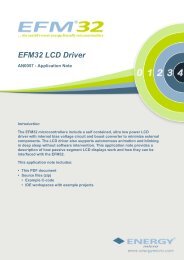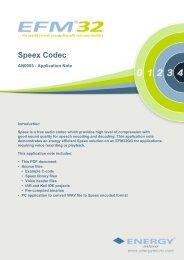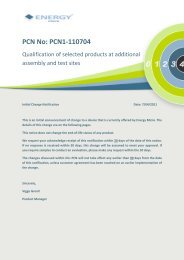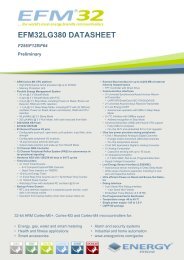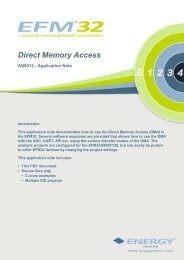EFM32 Debug and Trace - AN0043 - Application Note - Energy Micro
EFM32 Debug and Trace - AN0043 - Application Note - Energy Micro
EFM32 Debug and Trace - AN0043 - Application Note - Energy Micro
You also want an ePaper? Increase the reach of your titles
YUMPU automatically turns print PDFs into web optimized ePapers that Google loves.
5 Software Examples...the world's most energy friendly microcontrollersThis application note includes software examples for both the Tiny Gecko <strong>and</strong> Giant Gecko <strong>EFM32</strong>microcontrollers. The software examples demonstrate how to configure the <strong>EFM32</strong> to perform both SWOprintf, ITM trace <strong>and</strong> full ETM trace. (Please note that a debugger with J-<strong>Trace</strong> is only available on somekits, for example the DK3750/DK3650.)5.1 ITM printf OutputThis example uses the retargetio.c driver to make the CMSIS function ITM_SendChar(c) thedefault used by printf() to print characters.The example also demonstrates how one can use the other ITM-channels. The ITM_SendChar(charc) only uses channel 0. By defining a separate ITM_Port32(n) one can write 32 bit words to any ofthe 32 instrumentation trace channels. Notice that the software needs to wait until the channel buffer isready before it can be written to. The specific ITM ports must also be enabled in the SWO-configurationin the IDE. If just SWO output is needed without an IDE, the ITM ports must be enabled by the softwarerunning on the <strong>EFM32</strong>. Please see the TRACE_SWOSetup() function.5.2 <strong>Trace</strong> <strong>and</strong> ITM printf OutputThis example is exactly the same as the previous one, except that it is configured for the giant gecko<strong>and</strong> includes the TRACE_ETMSetup() function.5.3 <strong>Trace</strong> ProblemThis example demonstrates how one can use the instruction trace feature (included with the DK3750/DK3650 development kits) to debug software problems. The problems created on purpose in thisexample generates a hard fault in two different ways. In this example it is relatively easy to spot wherethe bugs are without instruction trace debugging. But since such problems usually occur deep withinlarger software project, it can be invaluable information to know which instructions were executed rightbefore the hard fault occurs.One of the bugs introduced is a stack overflow caused by recursion. The other bug is an illegal memoryaccess, caused by reading from a memory address which lies outside the defined memory blockfor the external bus interface (EBI). The illegal address hard fault can be selected by defining theILLEGAL_ADDRESS define.In both cases it is convenient to introduce a breakpoint in the hard fault h<strong>and</strong>ler. If not, the amount oftrace data after the hard fault occurs will be huge <strong>and</strong> it can cause trace buffer overflow.Because of the amount of RAM on the Giant Gecko device, it will take a few seconds before the stackoverflow causes a hard fault.5.4 More ExamplesMore information <strong>and</strong> several software examples can be found in the IAR CoreSight <strong>Debug</strong> <strong>and</strong> <strong>Trace</strong>tutorial:http://www.iar.com/Global/Resources/Developers_Toolbox/Building_<strong>and</strong>_debugging/Using_CoreSight_<strong>Trace</strong>_Techniques_on_Cortex-M3-M4/Using_CoreSight_<strong>Trace</strong>_Techniques_on_Cortex-M3-M4.pdf2013-05-08 - an0043_Rev1.02 22 www.energymicro.com



